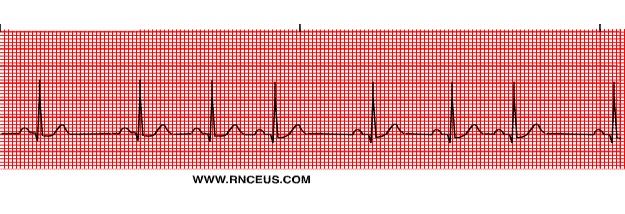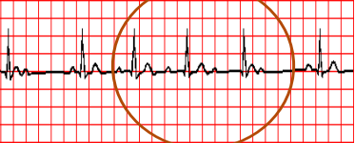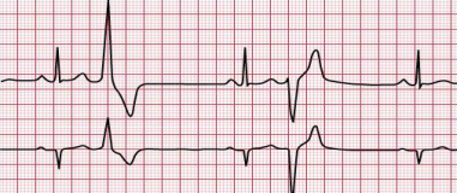Anesthesia: Electrocardiography (ECGs)
5.0(1)
Card Sorting
1/49
There's no tags or description
Looks like no tags are added yet.
Study Analytics
Name | Mastery | Learn | Test | Matching | Spaced |
|---|
No study sessions yet.
50 Terms
1
New cards
what is an ECG?
measurement of the electrical activity of the heart
will display the electrical impulses as waveforms
will display the electrical impulses as waveforms
2
New cards
what is the P wave
the firing of the SA node and atrial depolarization
3
New cards
what is the QRS complex
depolarization of the ventricles
4
New cards
what is the T wave
repolarization of the ventricles
5
New cards
what is the PR interval
measured from the beginning of the P wave to the beginning of the QRS complex
6
New cards
what is the QT interval
measured from the beginning of the QRS complex to the end of the T wave
7
New cards
what is the ST segment
measured from the end of the QRS complex to the beginning of the T wave
8
New cards
how to read ECG on paper
sweep speed ex: 25 mm/sec
find boxes ex: 30 large boxes
count QRS ex: 5 QRS
find your rate ex: 5 beats/6 sec
convert to beats/min ex: 5\*10= 50 beats/min
patients heart rate is 50 bpm
find boxes ex: 30 large boxes
count QRS ex: 5 QRS
find your rate ex: 5 beats/6 sec
convert to beats/min ex: 5\*10= 50 beats/min
patients heart rate is 50 bpm
9
New cards
Look at ECG Paper practive
paper practice
10
New cards
in a normal ECG what is normal to see
P wave in front of each QRS complex
QRS complex following each P wave
All Ps and QRS look the same and normal
P-R intervals are the same and normal in duration
R-R intervals are the same
QRS complex following each P wave
All Ps and QRS look the same and normal
P-R intervals are the same and normal in duration
R-R intervals are the same
11
New cards
how to remember to place the electrodes
white and black on jugular in the horse
red over the heart on the horse
white on right (right forelimb)
smoke over fire (black on forelimb red on hindlimb in the dog)
red over the heart on the horse
white on right (right forelimb)
smoke over fire (black on forelimb red on hindlimb in the dog)
12
New cards
what is seen in sinus arrhythmia
P wave in front of each QRS complex
QRS complex following each P wave
Ps and QRSs look the same and normal
P-R intervals are the same and normal duration
__R-R intervals are NOT the same__
QRS complex following each P wave
Ps and QRSs look the same and normal
P-R intervals are the same and normal duration
__R-R intervals are NOT the same__
13
New cards
what is sinus arrhythmia
a longer than normal space between QRS complexes
corresponds with breathing
during inspiration, the heart rate speeds up
during expiration, the heart rate slows down
regularly in athletic, sedated, or relaxed patients
corresponds with breathing
during inspiration, the heart rate speeds up
during expiration, the heart rate slows down
regularly in athletic, sedated, or relaxed patients
14
New cards
what is commonly seen in first degree AV block
A P wave in front of each QRS complex
A QRS complex following each P wave
Ps and QRSs look the same and normal
__P-R intervals are NOT the same and at a normal duration__
R-R intervals are the same
A QRS complex following each P wave
Ps and QRSs look the same and normal
__P-R intervals are NOT the same and at a normal duration__
R-R intervals are the same
15
New cards
what is a first degree AV block
conductive delay of the AV node
P-R interval longer than 0.2 seconds
usually seen if a paper strip is printed and measured
not usually treated
P-R interval longer than 0.2 seconds
usually seen if a paper strip is printed and measured
not usually treated
16
New cards
what is common to see with a second degree AV block
A P wave in front of each QRS complex
__A QRS complex is NOT following each P wave__
Ps and QRSs look the same and normal
__P-R interval is NOT the same and normal in duration__
__R-R intervals are NOT the same__
__A QRS complex is NOT following each P wave__
Ps and QRSs look the same and normal
__P-R interval is NOT the same and normal in duration__
__R-R intervals are NOT the same__
17
New cards
what is a second degree AV block
P-wave with no corresponding QRS complex
AV node fires but the signal is not conducted to the SA node
ventricles never depolarize
commonly seen under anesthesia
treated with an anticholinergic
AV node fires but the signal is not conducted to the SA node
ventricles never depolarize
commonly seen under anesthesia
treated with an anticholinergic
18
New cards
what is Mobitz type 1
second degree AV block
also known as Wenckebach rhythm
further further further dropped it is called the Wenckebach
P-R interval gradually increases until the QRS complex is dropped
also known as Wenckebach rhythm
further further further dropped it is called the Wenckebach
P-R interval gradually increases until the QRS complex is dropped
19
New cards
what is Mobitz type 2
second degree AV block
no lengthening of the P-R interval
sporadic dropped complexes
no lengthening of the P-R interval
sporadic dropped complexes
20
New cards
what is common to see in third degree AV block
A P wave in front of each QRS complex
__A QRS complex is NOT following each P wave__
__Ps and QRSs do NOT look the same and normal__
__P-R intervals are NOT the same and at a normal duration__
R-R intervals are the same
__A QRS complex is NOT following each P wave__
__Ps and QRSs do NOT look the same and normal__
__P-R intervals are NOT the same and at a normal duration__
R-R intervals are the same
21
New cards
what is a third degree AV block
complete heart block
no communication between the SA node and the AV node
atria are depolarizing at their own rate
the ventricles are depolarizing at their own, separate rate
treated with a pacemaker
no communication between the SA node and the AV node
atria are depolarizing at their own rate
the ventricles are depolarizing at their own, separate rate
treated with a pacemaker
22
New cards
what is common in an accelerated idioventricular rhythm (AIVR)
__A P wave is NOT in front of each QRS complex__
__A QRS complex is NOT following each P wave__
__Ps and QRSs do NOT look the same and normal__
__P-R intervals are NOT the same and at a normal duration__
R-R intervals are the same
__A QRS complex is NOT following each P wave__
__Ps and QRSs do NOT look the same and normal__
__P-R intervals are NOT the same and at a normal duration__
R-R intervals are the same
23
New cards
what is the accelerated idioventricular rhythm (AIVR)
wide, irregular QRS complexes
P waves and T waves are absent
associated with increased vagal tone and decreased sympathetic tone
anticholinergics can help override in some cases
treatment of the underlying cause is necessary for long term
P waves and T waves are absent
associated with increased vagal tone and decreased sympathetic tone
anticholinergics can help override in some cases
treatment of the underlying cause is necessary for long term
24
New cards
what is common in ventricular escape beats
__P wave is NOT in front of each QRS complex__
QRS complex are following each P wave
__Ps and QRSs are NOT the same and look normal__
__P-R intervals are NOT the same and at a normal duration__
__R-R intervals are NOT the same__
QRS complex are following each P wave
__Ps and QRSs are NOT the same and look normal__
__P-R intervals are NOT the same and at a normal duration__
__R-R intervals are NOT the same__
25
New cards
what are ventricular escape beats
wide, strange QRS complex after a long pause
associated with ventricles contracting independently due to lack of impulse from the SA node
can be caused from anesthetic drugs
treat with anticholinergic
associated with ventricles contracting independently due to lack of impulse from the SA node
can be caused from anesthetic drugs
treat with anticholinergic
26
New cards
what is common with ventricular premature contractions
__P wave is NOT in front of each QRS complex__
QRS complex are following each P wave
__Ps and QRSs are NOT the same and look normal__
P-R intervals are the same and at a normal duration
__R-R intervals are NOT the same__
QRS complex are following each P wave
__Ps and QRSs are NOT the same and look normal__
P-R intervals are the same and at a normal duration
__R-R intervals are NOT the same__
27
New cards
what are ventricular premature contractions (VPCs)
wide and abnormal ventricular contraction
ventricles contract too early in the heart rhythm
treated sometimes
treated with lidocaine or other antiarrhythmic
ventricles contract too early in the heart rhythm
treated sometimes
treated with lidocaine or other antiarrhythmic
28
New cards
what is common with ventricular tachycardia
__P wave is NOT in front of each QRS complex__
__QRS complex are NOT following each P wave__
__Ps and QRSs are NOT the same and look normal__
__P-R intervals are NOT the same and at a normal duration__
R-R intervals are the same
__QRS complex are NOT following each P wave__
__Ps and QRSs are NOT the same and look normal__
__P-R intervals are NOT the same and at a normal duration__
R-R intervals are the same
29
New cards
what is ventricular tachycardia
fast, bizarre looking QRS complexes with no P waves or T waves
no/very weak pulses
needs to be treated
\-lidocaine
\-beta blockers
\-calcium channel blockers
\-defibrillation
no/very weak pulses
needs to be treated
\-lidocaine
\-beta blockers
\-calcium channel blockers
\-defibrillation
30
New cards
what is common to see in ventricular fibrillation
__P wave is NOT in front of each QRS complex__
__QRS complex are NOT following each P wave__
__Ps and QRSs are NOT the same and look normal__
__P-R intervals are NOT the same and at a normal duration__
__R-R intervals are NOT the same__
__QRS complex are NOT following each P wave__
__Ps and QRSs are NOT the same and look normal__
__P-R intervals are NOT the same and at a normal duration__
__R-R intervals are NOT the same__
31
New cards
what is ventricular fibrillation
usually fatal arrhythmia
high heart rate with wide, strange QRS complexes
must be treated with defibrillator
high heart rate with wide, strange QRS complexes
must be treated with defibrillator
32
New cards
what is common to see in atrial fibrillation
__P wave is NOT in front of each QRS complex__
__QRS complex are NOT following each P wave__
__Ps and QRSs are NOT the same and look normal__
__P-R intervals are NOT the same and at a normal duration__
__R-R intervals are NOT the same__
__QRS complex are NOT following each P wave__
__Ps and QRSs are NOT the same and look normal__
__P-R intervals are NOT the same and at a normal duration__
__R-R intervals are NOT the same__
33
New cards
what is atrial fibrillation
looks like artifact
random small waves in between complexes
sign of deeper cardiac disease
further cardiac workup needed and treatment may be warranted
random small waves in between complexes
sign of deeper cardiac disease
further cardiac workup needed and treatment may be warranted
34
New cards
what is common to see in atrial flutter
P wave is in front of each QRS complex
__QRS complex are NOT following each P wave__
__Ps and QRSs are NOT the same and look normal__
__P-R intervals are NOT the same and at a normal duration__
__R-R intervals are NOT the same__
__QRS complex are NOT following each P wave__
__Ps and QRSs are NOT the same and look normal__
__P-R intervals are NOT the same and at a normal duration__
__R-R intervals are NOT the same__
35
New cards
what is atrial flutter
sawtooth, fluttery pattern
sign of deeper cardiac disease
further cardiac workup needed
sign of deeper cardiac disease
further cardiac workup needed
36
New cards

\
normal ECG
37
New cards

\
sinus arrhythmia
38
New cards

\
first degree AV block
39
New cards

\
second degree AV block
40
New cards

\
mobitz type 1
41
New cards

\
mobitz type 2
42
New cards

\
third degree AV block
43
New cards

\
accelerated idioventricular rhythm
44
New cards

\
ventricular escape beats
45
New cards

\
unifocal ventricular premature contractions
46
New cards

\
multifocal ventricular premature contractions
47
New cards

\
ventricular tachycardia
48
New cards

\
ventricular fibrillation
49
New cards

\
atrial fibrillation
50
New cards

\
atrial flutter